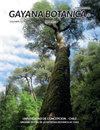Effects of UV-B radiation on the morphology, UV-B absorbing compounds and photosynthetic pigment content of Plantago lanceolata and Rheum rhabarbarum
IF 0.5
4区 生物学
Q4 PLANT SCIENCES
引用次数: 0
Abstract
In recent decades the fluence of ultraviolet-B (UV-B) radiation striking the ground has increased as a consequence of ozone depletion at southern latitudes. This phenomenon has sparked much interest in unravelling how plants acclimate to this condition. UV-B radiation triggers several responses that affect plant physiology, morphology and biochemistry. In this study, the effects of supplemental UV-B radiation on plant architecture, UV-B absorbing compounds and photosynthetic pigments were analyzed in two cosmopolitan species. A different range of responsiveness was found in the morphological parameters (leaf area, length and width; plant height) of species. The effects on photosynthetic pigment content and the UV-B absorbing compounds were studied through absorbance measurements. The obtained data showed that only carotenoids increased in irradiated plants of R. rhabarabarum. Likewise, an increase in the UV-B absorbing compounds content was found in irradiated plants from the same species. This effect may be regarded as a chemical protection against the damaging effects of light in photosynthesis and against oxidative cell damage. UV-B radiation induced photomorphogenic responses. In fact, all the morphological parameters of P. lanceolata were increased. The clear increase shown in leaf size and plant height suggest that cell division and stem elongation and/or differentiation processes are stimulated by UV-B radiation. These changes can be seen as an eustress effect and may indicate that plants are physiologically adapted to this level of UV-B radiation.UV-B辐射对车前草和大黄形态、吸收UV-B化合物及光合色素含量的影响
近几十年来,由于南纬地区臭氧耗竭,照射到地面的紫外线- b (UV-B)辐射增加了。这一现象引发了人们对揭示植物如何适应这种条件的兴趣。UV-B辐射引发了几种影响植物生理、形态和生物化学的反应。在本研究中,分析了补充UV-B辐射对两种世界性植物的结构、吸收UV-B的化合物和光合色素的影响。不同形态参数(叶面积、叶长、叶宽)的响应性不同;种的株高。通过吸光度测定,研究了其对光合色素含量和UV-B吸收化合物的影响。结果表明,辐照后的黄颡鱼只有类胡萝卜素增加。同样,在同一物种的辐照植物中发现吸收UV-B的化合物含量增加。这种作用可以被认为是一种化学保护,防止光在光合作用中的破坏作用和防止氧化细胞损伤。UV-B辐射诱导光形态形成反应。事实上,杉木的所有形态参数都增加了。叶片大小和株高的明显增加表明,UV-B辐射刺激了细胞分裂和茎伸长和/或分化过程。这些变化可以看作是一种胁迫效应,可能表明植物在生理上适应了这种水平的UV-B辐射。
本文章由计算机程序翻译,如有差异,请以英文原文为准。
求助全文
约1分钟内获得全文
求助全文
来源期刊

GAYANA BOTANICA
Agricultural and Biological Sciences-Plant Science
CiteScore
0.70
自引率
0.00%
发文量
8
审稿时长
6-12 weeks
期刊介绍:
The journal welcomes works carried out by scientists of all nationalities, and may be written in either English or Spanish. The journal receives works in systematic, taxonomy, floristic, ecology, physiology, morphology, development, conservation, cytology and phytochemical botany.
 求助内容:
求助内容: 应助结果提醒方式:
应助结果提醒方式:


